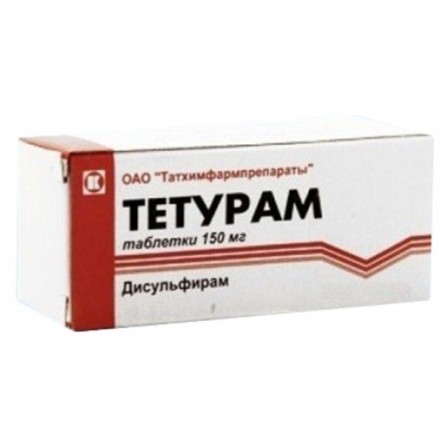More info
Active ingredients
Disulfiram
Release form
Pills
Composition
Tablets 1 tab. disulfiram 150 mg.
Pharmacological effect
The agent for the treatment of alcohol dependence. It has an inhibitory effect on the enzyme aldehyde dehydrogenase, which is involved in the metabolism of ethanol. This leads to an increase in the concentration of the metabolite of etatol - acetaldehyde, which causes flushing, nausea, vomiting, general malaise, tachycardia, a decrease in blood pressure, which make alcohol consumption extremely unpleasant after taking disulfiram.
Pharmacokinetics
After ingestion, rapid, but incomplete (70-90%) absorption of the active substance from the gastrointestinal tract occurs. Due to its high solubility in lipids, disulfiram is widely distributed in the body and accumulates in various fat depots. Disulfiram is rapidly metabolized to diethyldithiocarbamate (DDC), which is partially excreted as carbon disulfide with exhaled air and partially metabolized in the liver by methyl-DDC. The latter is converted to the active metabolite - diethylthiocarbamic acid methyl ester (methyl-DTC). Cmax in methyl-DTK plasma is reached 4 h after administration of disulfiram, but the maximum inhibitory activity against aldehyde dehydrogenase is first observed after 3 days of administration. T1 / 2 methyl-DTC is about 10 hours, while the inhibitory activity against aldehyde dehydrogenase lasts much longer. The effect can thus be maintained for 7-14 days after cancellation. With a weak or moderate deterioration in liver function, the metabolism does not change. In contrast, in liver cirrhosis, an increase in the concentration of metabolites in the blood is observed. Metabolites are excreted mainly in the urine. Part of the output with exhaled air in the form of carbon disulfide. 20% in the form of unchanged disulfiram is excreted through the intestines. Up to 20% of the dose can remain in the body for 1 week or more. After implantation, disulfiram penetrates the blood. The minimum content of disulfiram in the blood is about 20 ng / ml. The blood concentration of DDC and carbon disulfide reaches 0.14 mcg / ml after implantation of 1-1.6 g disulfiram. However, despite these very low levels, disulfiram-ethanol reactions may occur within 5-9 months after implantation.
Indications
For oral administration: prevention of relapse during treatment of chronic alcoholism. For implantation: treatment of chronic alcoholism, as a detoxification agent for chronic nickel poisoning.
Contraindications
Severe cardiovascular diseases, severe liver failure, diabetes mellitus, epilepsy, neuropsychiatric diseases, simultaneous administration of phenytoin, isoniazid, metronidazole, simultaneous consumption of alcoholic beverages or medication containing ethanol, as well as their consumption within 24 hours after ingestion disulfiramaberemennost, lactation and increased sensitivity to disulfiram.
Use during pregnancy and lactation
Contraindicated for use during pregnancy and lactation. Pregnancy should be excluded before implantation. Against the background of the action of disulfiram, it is necessary to use reliable contraception.
Dosage and administration
When ingestion dose is 125-500 mg / day, the treatment regimen is determined individually. When implanted into the subcutaneous fat using a special technique, 800 mg is administered.
Side effects
On the part of the digestive system: metallic taste in the mouth; rarely, hepatitis. From the side of the central nervous system: polyneuritis of the lower extremities, neuropsychiatric disorders, memory loss, disorientation, headache. Allergic reactions: skin rash, itching. Reactions due to the association of disulfiram-ethanol: collapse, cardiac arrhythmias, strokes, myocardial infarction, brain swelling.
Interaction with other drugs
When applied simultaneously with anticoagulants coumarin derivatives (including with warfarin) increases the anticoagulant effect, increases the risk of bleeding. Disulfiram inhibits liver enzymes, therefore, with simultaneous use of drugs metabolized in the liver, a violation of their metabolism is possible. With the simultaneous use of disulfiram with tricyclic antidepressants, phenothiazine derivatives, MAO inhibitors, there is a risk of serious adverse reactions associated with drug interactions. A case of the development of mania in a patient taking disulfiram and buspirone is described.With simultaneous use decreases the clearance of desipramine and imipramine from the body. With simultaneous use with amitriptyline, it is possible to enhance the therapeutic effect of disulfiram, but it is also possible to increase the toxic effect of amitriptyline on the CNS. With simultaneous use increases in plasma concentration of diazepam and chlordiazepoxide, in some cases accompanied by dizziness. Under the influence of diazepam, a decrease in the intensity of the disulfiram-ethanol reaction is possible. Described case of increasing the toxicity of temazepam. With simultaneous use with isoniazid described cases of dizziness, depression; caffeine - reduced excretion of caffeine from the body; with metronidazole - acute psychosis, confusion; with omeprazole - described a case of developmental disorders of consciousness and catatonia. When applied simultaneously with perphenazine, the development of psychotic symptoms cannot be excluded. With the simultaneous use of disulfiram inhibits metabolism and elimination of rifampicin. With simultaneous use with phenazone T1 / 2 phenazone increases; with phenytoin - the effects of phenytoin are enhanced due to an increase in its concentration in the blood plasma, toxic reactions develop. With simultaneous use with chlorzoxazone, the concentration of chlorzoxazone in the blood plasma increases; with chlorpromazine - possible increase in arterial hypotension.
special instructions
Use with caution in patients with renal insufficiency, diseases of the liver, respiratory system.



